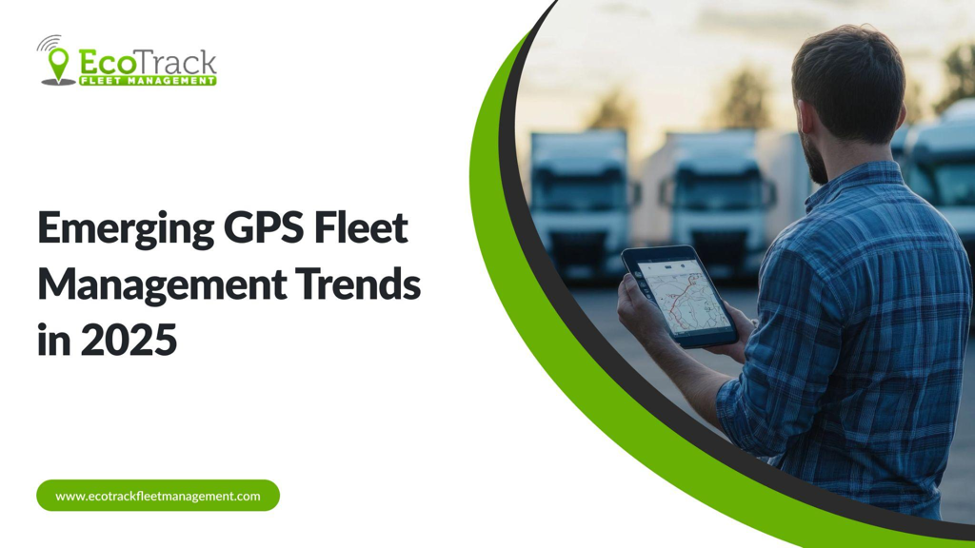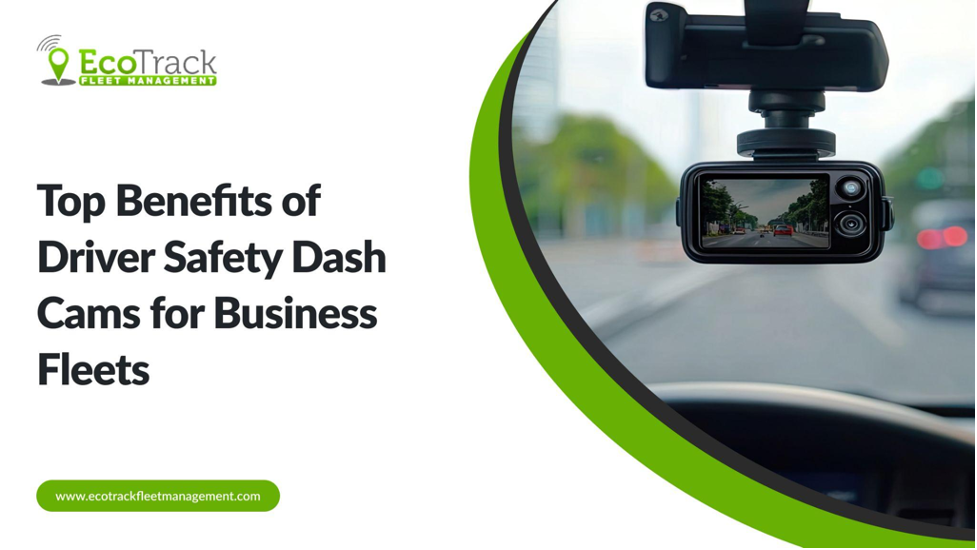Today, GPS in commercial fleets has moved well beyond simple vehicle tracking. Fleets are now tapping into advanced telematics systems that bring together GPS, onboard diagnostics, sensor data, and wireless connectivity into a single, connected network.
The result is a continuous stream of real-time insights that enhances daily operations, driving greater efficiency, safety, and sustainability.
When discussing GPS fleet management trends for 2025, telematics don’t just show a vehicle’s location; they provide a comprehensive picture, encompassing performance monitoring and predictive maintenance. The challenge, however, is that many fleets still struggle to make sense of this flood of information. That’s where more intelligent analytics and automation tools are stepping in, turning raw data into clear, actionable decisions.
In this blog, we’ll break down the key GPS fleet management trends for 2025, including predictive maintenance, AI-powered routing, IoT connectivity, and safety-focused technologies, that are helping fleets get more out of every mile.
1. Predictive Maintenance & Real-Time Diagnostics
Fleets are moving from calendar-based servicing to condition-based, predictive maintenance. By continuously monitoring engine health, tire pressure, brake condition, and other sensor data, telematics systems can forecast failures before they happen.
This shift highlights one of the most critical GPS fleet management trends for 2025: using real-time diagnostics to minimize downtime and cut repair costs. With proactive alerts and automated maintenance scheduling, fleets not only save money but also improve FMCSA compliance and road safety.
Academic analysis notes that telematics enables a shift “from scheduled to condition-based servicing”. In practice, industry reports confirm that this trend slashes downtime and costs: predictive maintenance “offers significant advantages including reduced downtime, lower repair costs, and improved safety”.
For example, FreightWaves explains that modern fleets use GPS/OBD telematics and AI-driven diagnostics to trigger service alerts exactly when needed. By automating repair scheduling based on real data (rather than fixed intervals), fleets “track key vehicle components and detect warning signs before a failure occurs.”
In short, real-time diagnostics from telematics – often powered by machine learning – are turning reactive repair into proactive planning, keeping more trucks safely on the road.
- Lower Downtime & Costs: Telematics data (engine codes, vibration, etc.) is analyzed to predict failures. Fleets can then service vehicles just before parts fail, significantly reducing breakdowns.
- Continuous Health Monitoring: Modern telematics platforms integrate driver-reported inspections with live engine data. This enables “full-time vehicle diagnostics” and automated fault detection. Fleets get instant alerts on issues (e.g., low oil pressure), improving FMCSA compliance.
- Improved Compliance & Safety: A condition-based program ensures trucks are maintained based on actual use. Industry analysis shows this yields better CSA scores and safer operation. In short, predictive analytics applied to telematics data is becoming the gold standard for maximizing fleet uptime and safety.
2. AI-Powered Analytics & Routing Optimization
Artificial intelligence and machine learning are now embedded throughout fleet operations. AI’s chief benefit is giving managers “the immediacy of information” on fuel use, routing, and safety. For example, advanced systems allow natural-language queries of historical telematics data: one platform lets users ask questions via chat to get instant insights from years of GPS and engine logs.
Similarly, AI engines constantly optimize routing: they ingest live traffic, weather, and delivery windows to generate efficient routes on the fly. Leading vendors have introduced AI-powered route engineering tools that recalculate paths dynamically. In aggregate, AI is supercharging fleet analytics:
- Conversational Telematics: Large language models can now interface with fleet data. Managers can ask a chatbot for summaries (e.g., “Which truck had the highest downtime last month?”) and get immediate answers from the telematics database.
- Dynamic Routing: AI-driven routing platforms adjust delivery schedules in real time. By continuously learning from traffic and historical patterns, they reduce miles and drive times. This not only saves fuel but also improves on-time performance.
- Fuel & Asset Efficiency: Machine learning tools analyze operational data (loads, routes, driver styles) to benchmark fuel use and suggest improvements. For example, a new service compares trucks’ fuel efficiency under varying loads using AI, helping fleets adopt more efficient driving or equipment.
- Machine Learning Integration: Industry experts identify six high-impact AI areas for fleets, including data analysis, fuel efficiency, routing, asset management, and safety. In 2025, these converge: AI systems digest telematics streams and legacy records together, turning raw GPS pings and engine logs into predictive decisions.
Among the most impactful GPS fleet management trends in 2025 is this move toward AI-powered routing. It reduces delays, lowers fuel consumption, and helps fleets deliver on time, every time.
3. Advanced Connectivity (5G, IoT & Sensors)
Telematics hardware is becoming more sophisticated. Fleets now outfit vehicles with myriad IoT sensors (for cargo temperature, tire health, load weight, etc.) that feed into the GPS network. These devices, combined with high-bandwidth communications, enable near-instantaneous data flow. Industry analysts note that the rollout of 5G wireless and the Internet of Things is “revolutionizing fleet management, enabling real-time data processing and automation”. In practice, this means trucks are essentially moving data hubs:
- Integrated Sensors: Modern trucks carry dozens of connected sensors. For example, GPS position is augmented with onboard diagnostics and satellite data to give a full picture of the vehicle’s state. As one review observes, fleet telematics now fuses “GPS tracking, onboard diagnostics, sensor technology, and wireless communication” into a single data ecosystem. This connectivity supports everything from precise route guidance to cargo security alerts.
- High-Speed Links: 5G and expanding cellular/satellite coverage let fleets stream video and diagnostic data continuously. For instance, live camera feeds and real-time engine metrics can be uploaded to the cloud with minimal latency. The result is truly real-time fleet visibility: dispatchers see trucks’ locations, statuses, and even driving events almost instantly. As noted by market analysts, this connectivity “enables real-time tracking and monitoring” of vehicles.
- Connected Vehicle Future: The trend toward connected fleets also encompasses vehicle-to-infrastructure communication. In the coming years, roadside beacons and smart highways may communicate with truck telematics to alert drivers to traffic or hazards. Though still emerging, such V2X integration is on the roadmap for advanced US fleets.
The integration of IoT sensors and high-speed connectivity is one of the defining trends in GPS fleet management for 2025, enabling real-time processing, improved visibility, and predictive automation across the supply chain.
4. Driver Monitoring & Safety Systems
Safety technology is one of the fastest-growing areas of telematics. Beyond GPS, fleets are installing in-cab and windshield cameras, dashcams, and driver biometrics linked to AI. The goal is to monitor driver behavior continuously and coach improvement.
Indeed, industry research notes that “with continued advances in technology focused on in-cab monitoring, more fleets are turning to these systems to better understand driver behaviors in the cab”. AI-powered analytics then score behaviors (harsh braking, drowsiness, phone use) for proactive coaching.
Key developments include:
- AI Dashcams & Coaching: Systems like EcoTrack’s use inward- and outward-facing cameras with onboard AI. They detect common risks (distracted driving, microsleep, following distance) and provide real-time alerts or post-trip scores. For example, one telematics provider “launched AI-powered drowsiness detection” on driver cameras, instantly flagging fatigue events.
- Driver Behavior Analytics: Telematics platforms aggregate braking, acceleration, speed, and lane-change data for each driver. These metrics feed machine-learning models that identify high-risk drivers or unsafe patterns. Fleet managers can then target training or incentives to improve overall safety.
- Safety Outcomes: Early results are promising: FleetOwner reports that AI-enhanced video analytics are already reducing accidents and driving risks. One article notes “video-based telematics… moving very aggressively… [with] increased accident reduction and increased driving risk reduction”. In short, combining GPS tracking with active driver monitoring is making US fleets measurably safer.
5. Automation & Intelligent Data Integration
Finally, fleet management software itself is becoming more automated and intelligent. The surge of telematics data necessitates more innovative back-end tools. Two emerging trends stand out:
- AI-Driven Workflow Automation: “Agentic” AI platforms are on the rise. These place a single AI interface in front of users that can trigger multiple automated workflows behind the scenes. For instance, instead of manually reconciling shipments, an AI agent could collect invoices, compare them against GPS logs, and even initiate billing—much like a virtual assistant. Similarly, some systems now automatically generate maintenance work orders when telematics alerts to a fault, without human intervention.
- Multimodal Data Processing: Artificial intelligence can now effectively merge diverse data sources. LLMs and vision models can read scanned documents, audio notes, and camera footage as easily as text. In fleet operations, this means that paper forms, bills of lading, and video clips can all be integrated into a single analysis. As one expert explains, modern AI can “connect with data… textual information, audio information, and video information, and process it in one go”. Practically, fleets are starting to see automated fleet logs (from dashboard camera video) and digital trip reports generated without manual data entry.
Overall, the GPS fleet management trends of 2025, predictive maintenance, AI optimization, IoT connectivity, safety monitoring, and automation are reshaping the industry. Fleets that adapt quickly will thrive, gaining efficiency, reducing costs, and safeguarding operations in an increasingly competitive market.
As one industry survey puts it, the competitive gap is growing: fleets that “move quickly… and adopt systems that scale” will thrive. And if you seek that competitive advantage without actually taking a toll on your business, then join hands with EcoTrack Fleet Management.
Stay Ahead With EcoTrack Fleet Management
In 2025, fleets can’t rely on GPS location alone; success comes from integrating smarter, data-driven tools that adapt in real time. That’s precisely what EcoTrack delivers.
With intelligent routing powered by live traffic, AI-driven cams, and predictive analytics, EcoTrack gives you more than fleet visibility; it gives you an operational edge:
- Smarter Dispatching: Assign the closest vehicle instantly and keep trips on schedule.
- Lower Fuel Costs: Cut idling, avoid detours, and optimize every route dynamically.
- Real-Time Risk Alerts: Get notified of unsafe driving, breakdowns, or sudden delays before they escalate.
- Data-Driven Insights: Turn telematics into strategy with reports that highlight performance gaps and savings opportunities.
- Enhanced Service: Deliver accurate ETAs, back claims with proof, and build trust with your customers.
EcoTrack makes it easier to embrace the trends shaping GPS fleet management, growing with the latest trends, helping your operation become leaner, safer, and more competitive.
Book your demo today and discover how EcoTrack turns GPS data into tangible results.









